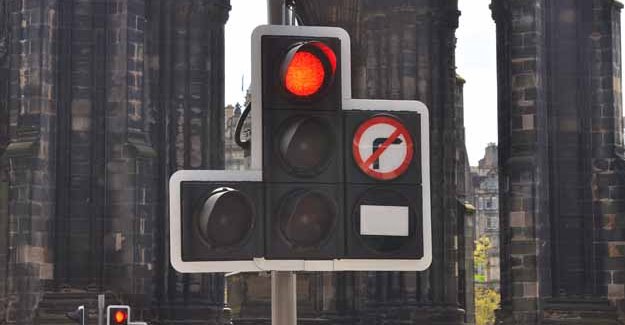Stuck at red? The rise and rise of the traffic light
Ever think you are spending more time sitting at the lights? Well you probably are, because the number of sets of traffic lights in Britain jumped by some 30 per cent between 2000 and 2008.
In London, over the same period, the numbers rose by about a quarter to more than 6,000.
Unpublished figures from the Department for Transport (DfT) also show that by the end of 2008, some 8,500 sets of lights were programmed to give priority to buses – 3,200 of them in the Capital.
About half of all traffic lights are at junctions, the rest are at stand-alone pedestrian crossings.
The information is revealed in Every Second Counts, a report for the RAC Foundation by Irving Yass, into the operation of traffic lights – which were first introduced into the UK in the 1920s – and their impact on congestion and safety.
The report says traffic lights do deliver economic and safety benefits, but not at every location and not all of the time. The report notes that:
• The DfT should consider carrying out trials of flashing amber lights at times when there is little traffic, which would allow drivers to proceed with caution at junctions, as is common in countries such as France and Italy.
• London trials of a reduction of the green-man phase (the invitation to cross) from ten seconds to six seconds have increased traffic flow by six and a half per cent with no significant impact on safety. In the light of these findings, authorities should consider standardising the green man invitation to cross period at six seconds.
• It is not widely understood that the full length of time that pedestrians have to cross is not just the green man period but also includes the time when the pedestrian sign is blank. There are other forms of pedestrian signals – Pedestrian User-Friendly Intelligent (puffin) and countdown, currently being trialed at eight sites in London – that avoid this problem.
• The DfT should also allow for trialling of cyclists turning left at a red signal.
• More use should be made of ‘smart’ traffic lights systems, such as SCOOT, which respond to changes in traffic and congestion by altering the timing of lights.
• The most significant change in priorities over the past decade has been for the benefit of pedestrians, with a presumption – since 2005 – that at junctions there will be an all-round pedestrian stage, i.e. all vehicles are held at red whilst people cross. There should be a review of effectiveness of full pedestrian crossing stages and whether the benefits outweigh costs.
• Local authorities should review the lights they have and consider whether some could be removed and replaced with alternatives such as mini-roundabouts and shared space schemes, though not at disproportionate cost to taxpayers.
Commenting on the report, Professor Stephen Glaister, director of the RAC Foundation, said:
“Depending when and where you are, traffic lights can ease your journey or be a source of frustration. It is plain that lights have an important role to play but with ever more congested streets they need to be very finely tuned to ensure they are not doing more harm than good – and that means they must react to changing traffic conditions.
“The Department for Transport is nervous of introducing flashing amber signals on the grounds of safety, but they do seem to work in other countries. It is time for the DfT to think again.”
ENDS
Contact:
Philip Gomm – Head of External Communications – RAC Foundation
[email protected] <mailto:[email protected]> / 020 7747 3486 / 07711 776448
Notes to Editors:
The RAC Foundation is a charity that explores the economic, mobility, safety and environmental issues relating to roads and responsible road users. Independent, authoritative research, carried out for the public benefit, is central to the Foundation’s activities.
Irving Yass spent thirty-six years in government service, in the Departments of Transport and Environment, ending as Director of Planning and Transport at the Government Office for London. He was Director of Transport and then Director of Policy at London First until the end of 2008, since when he has been working as an independent consultant.
Transport for London estimates congestion costs £2 billion a year in London alone.
There are no absolute figures for the number of traffic lights in Britain, but the percentage increases are based on data obtained by the DfT from the majority of local authorities including the major urban councils.
According to the report:
“ The development of SCOOT (Split-Cycle Offset Optimisation Technique) allowed the phasing of a linked set of signals to respond to changing traffic conditions in real time. In congested urban traffic conditions queues build up very quickly. Fine adjustments to the timing of traffic lights can make a huge difference to traffic flow. Literally, every second counts.
“There has been a big increase in the number of traffic lights in recent years. A survey by the Department for Transport (DfT) (unpublished) shows that the number of installations increased by more than 30% between 2000 and 2008. The increase in London was 23%. At the same time, the aim of reducing traffic congestion has been subject to other objectives: to make roads safer and more convenient for pedestrians, including those with disabilities; to give priority to buses; to promote cycling; and to reduce the number of accidents. These objectives have been reflected in standards and guidance issued by DfT and the policies of local authorities.”
“The DfT survey (unpublished) shows that the number of traffic signals equipped to give priority to buses more than doubled between the beginning of 2007 and the end of 2008, from 3,801 to 8,425, 3,200 of them in London. The number of junctions in London with a full pedestrian crossing stage, i.e. all the vehicle signals held at red, has increased from 481 in 2000 to 783 in 2010.”


